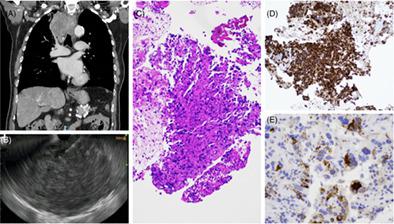当前位置:
X-MOL 学术
›
J. Dig. Dis.
›
论文详情
Our official English website, www.x-mol.net, welcomes your
feedback! (Note: you will need to create a separate account there.)
The evolving role of EUS‐guided tissue acquisition
Journal of Digestive Diseases ( IF 2.3 ) Pub Date : 2021-02-21 , DOI: 10.1111/1751-2980.12976 Tiing Leong Ang 1 , Lai Mun Wang 2
Journal of Digestive Diseases ( IF 2.3 ) Pub Date : 2021-02-21 , DOI: 10.1111/1751-2980.12976 Tiing Leong Ang 1 , Lai Mun Wang 2
Affiliation

|
The introduction of endoscopic ultrasound‐guided fine‐needle aspiration into clinical practice was a pivotal moment for diagnostic gastrointestinal endoscopy. It facilitates the ease of tissue acquisition from previously inaccessible sites. The performance characteristics of cytological diagnosis are excellent. However, there remain areas of inadequacies. These include procedural inefficiencies such as the need for rapid on‐site cytological evaluation or macroscopic on‐site evaluation, the crucial role of histology for diagnosis in specific conditions, the issue of sampling errors and the need for repeat procedures, and the shift towards personalized medicine, which requires histology, immunohistochemical studies, and molecular analysis. The original Trucut biopsy needle had been cumbersome to use, but the recent introduction of newer‐generation biopsy needles has transformed the landscape, such that there is now a greater focus on tissue acquisition for histological assessment. Concomitant technological advances of endoscopic ultrasound processors enabled higher‐resolution imaging, and facilitated image enhancement using contrast harmonic endoscopic ultrasound and endoscopic ultrasound elastography. These techniques can be used as an adjunct to guide tissue acquisition in challenging situations. There is ongoing research on the use of artificial intelligence to complement diagnostic endoscopic ultrasound and the early data are promising. Artificial intelligence may be especially important to guide clinical decision‐making if biopsy results are nondiagnostic.
中文翻译:

EUS 引导的组织采集的演变作用
将内镜超声引导下的细针穿刺引入临床实践是诊断性胃肠内镜检查的关键时刻。它有助于从以前无法访问的站点轻松获取组织。细胞学诊断的性能特点非常好。然而,仍有不足之处。这些包括程序效率低下,例如需要快速的现场细胞学评估或宏观现场评估、组织学在特定条件下诊断的关键作用、采样错误问题和重复程序的需要,以及向个性化的转变医学,这需要组织学、免疫组织化学研究和分子分析。最初的 Trucut 活检针使用起来很麻烦,但最近推出的新一代活检针改变了格局,因此现在更加关注用于组织学评估的组织采集。内窥镜超声处理器的伴随技术进步实现了更高分辨率的成像,并促进了使用对比谐波内窥镜超声和内窥镜超声弹性成像的图像增强。这些技术可用作辅助手段,在具有挑战性的情况下指导组织采集。正在进行关于使用人工智能来补充诊断内窥镜超声的研究,早期数据很有希望。如果活检结果无法诊断,人工智能可能对指导临床决策尤为重要。因此,现在更加关注用于组织学评估的组织采集。内窥镜超声处理器的伴随技术进步实现了更高分辨率的成像,并促进了使用对比谐波内窥镜超声和内窥镜超声弹性成像的图像增强。这些技术可用作辅助手段,在具有挑战性的情况下指导组织采集。正在进行关于使用人工智能来补充诊断内窥镜超声的研究,早期数据很有希望。如果活检结果无法诊断,人工智能可能对指导临床决策尤为重要。因此,现在更加关注用于组织学评估的组织采集。内窥镜超声处理器的伴随技术进步实现了更高分辨率的成像,并促进了使用对比谐波内窥镜超声和内窥镜超声弹性成像的图像增强。这些技术可用作辅助手段,在具有挑战性的情况下指导组织采集。正在进行关于使用人工智能来补充诊断内窥镜超声的研究,早期数据很有希望。如果活检结果无法诊断,人工智能可能对指导临床决策尤为重要。并使用对比谐波内窥镜超声和内窥镜超声弹性成像促进图像增强。这些技术可用作辅助手段,在具有挑战性的情况下指导组织采集。正在进行关于使用人工智能来补充诊断内窥镜超声的研究,早期数据很有希望。如果活检结果无法诊断,人工智能可能对指导临床决策尤为重要。并使用对比谐波内窥镜超声和内窥镜超声弹性成像促进图像增强。这些技术可用作辅助手段,在具有挑战性的情况下指导组织采集。正在进行关于使用人工智能来补充诊断内窥镜超声的研究,早期数据很有希望。如果活检结果无法诊断,人工智能可能对指导临床决策尤为重要。
更新日期:2021-04-12
中文翻译:

EUS 引导的组织采集的演变作用
将内镜超声引导下的细针穿刺引入临床实践是诊断性胃肠内镜检查的关键时刻。它有助于从以前无法访问的站点轻松获取组织。细胞学诊断的性能特点非常好。然而,仍有不足之处。这些包括程序效率低下,例如需要快速的现场细胞学评估或宏观现场评估、组织学在特定条件下诊断的关键作用、采样错误问题和重复程序的需要,以及向个性化的转变医学,这需要组织学、免疫组织化学研究和分子分析。最初的 Trucut 活检针使用起来很麻烦,但最近推出的新一代活检针改变了格局,因此现在更加关注用于组织学评估的组织采集。内窥镜超声处理器的伴随技术进步实现了更高分辨率的成像,并促进了使用对比谐波内窥镜超声和内窥镜超声弹性成像的图像增强。这些技术可用作辅助手段,在具有挑战性的情况下指导组织采集。正在进行关于使用人工智能来补充诊断内窥镜超声的研究,早期数据很有希望。如果活检结果无法诊断,人工智能可能对指导临床决策尤为重要。因此,现在更加关注用于组织学评估的组织采集。内窥镜超声处理器的伴随技术进步实现了更高分辨率的成像,并促进了使用对比谐波内窥镜超声和内窥镜超声弹性成像的图像增强。这些技术可用作辅助手段,在具有挑战性的情况下指导组织采集。正在进行关于使用人工智能来补充诊断内窥镜超声的研究,早期数据很有希望。如果活检结果无法诊断,人工智能可能对指导临床决策尤为重要。因此,现在更加关注用于组织学评估的组织采集。内窥镜超声处理器的伴随技术进步实现了更高分辨率的成像,并促进了使用对比谐波内窥镜超声和内窥镜超声弹性成像的图像增强。这些技术可用作辅助手段,在具有挑战性的情况下指导组织采集。正在进行关于使用人工智能来补充诊断内窥镜超声的研究,早期数据很有希望。如果活检结果无法诊断,人工智能可能对指导临床决策尤为重要。并使用对比谐波内窥镜超声和内窥镜超声弹性成像促进图像增强。这些技术可用作辅助手段,在具有挑战性的情况下指导组织采集。正在进行关于使用人工智能来补充诊断内窥镜超声的研究,早期数据很有希望。如果活检结果无法诊断,人工智能可能对指导临床决策尤为重要。并使用对比谐波内窥镜超声和内窥镜超声弹性成像促进图像增强。这些技术可用作辅助手段,在具有挑战性的情况下指导组织采集。正在进行关于使用人工智能来补充诊断内窥镜超声的研究,早期数据很有希望。如果活检结果无法诊断,人工智能可能对指导临床决策尤为重要。











































 京公网安备 11010802027423号
京公网安备 11010802027423号